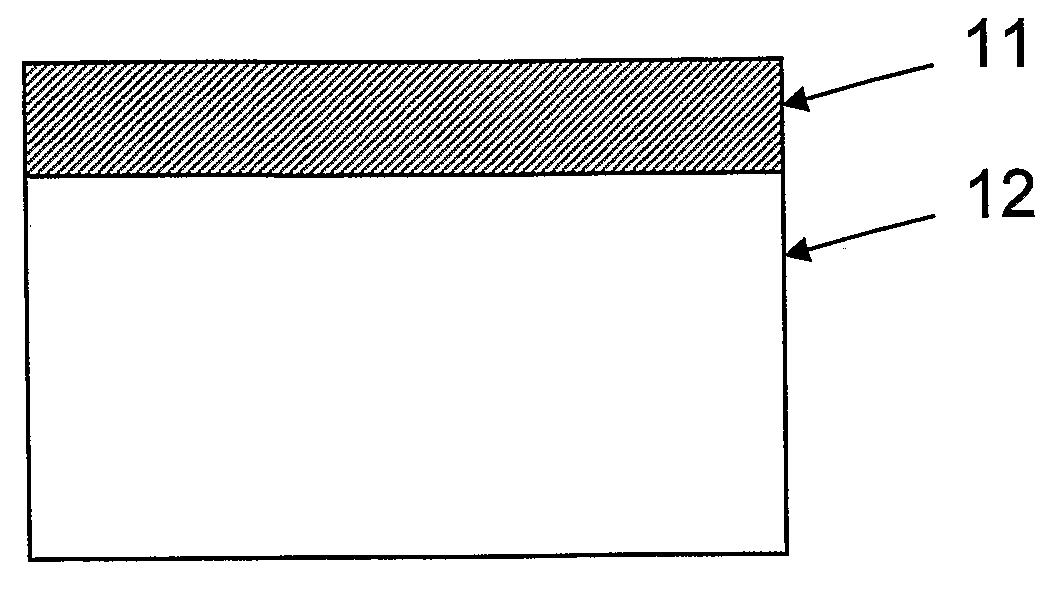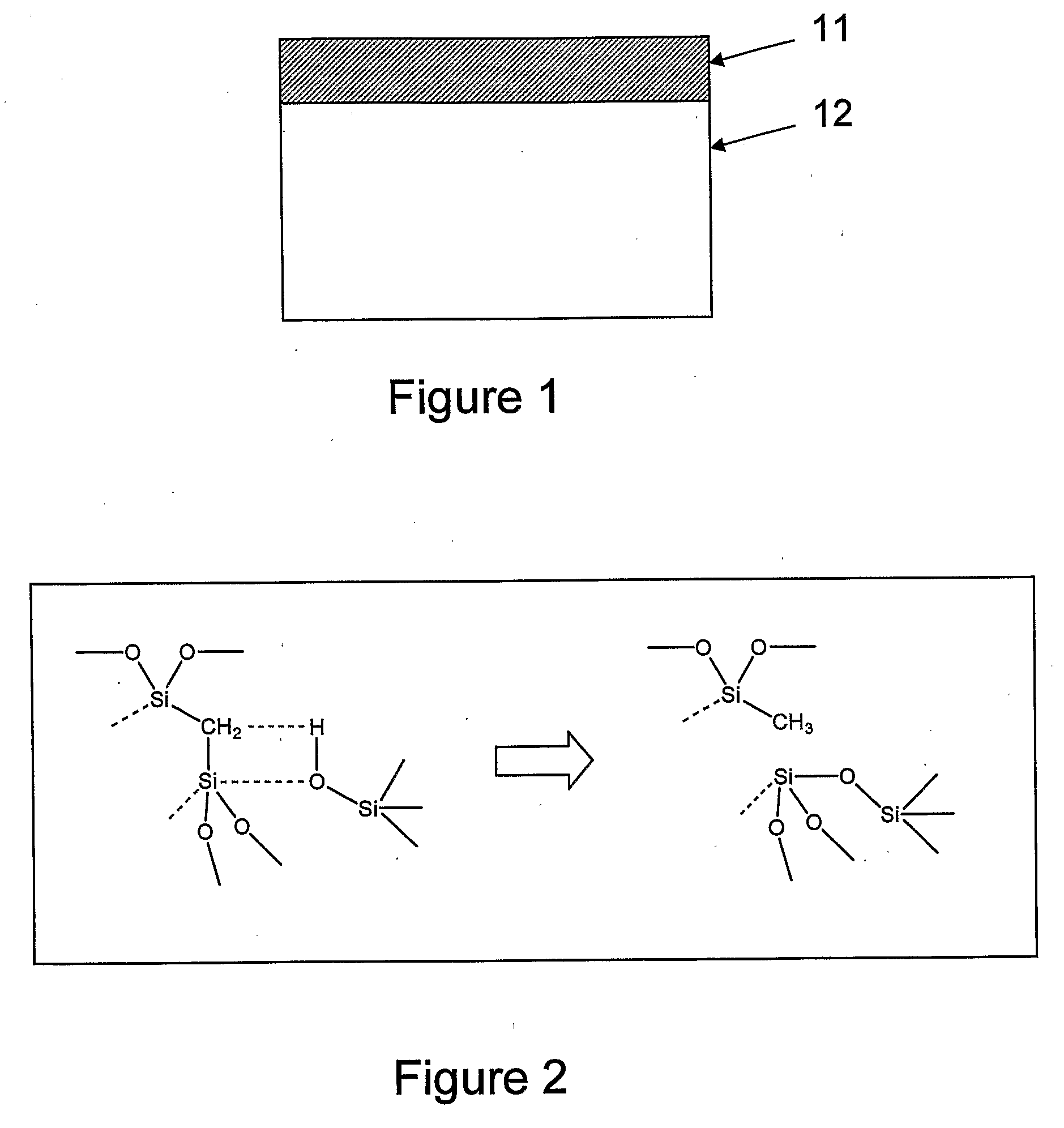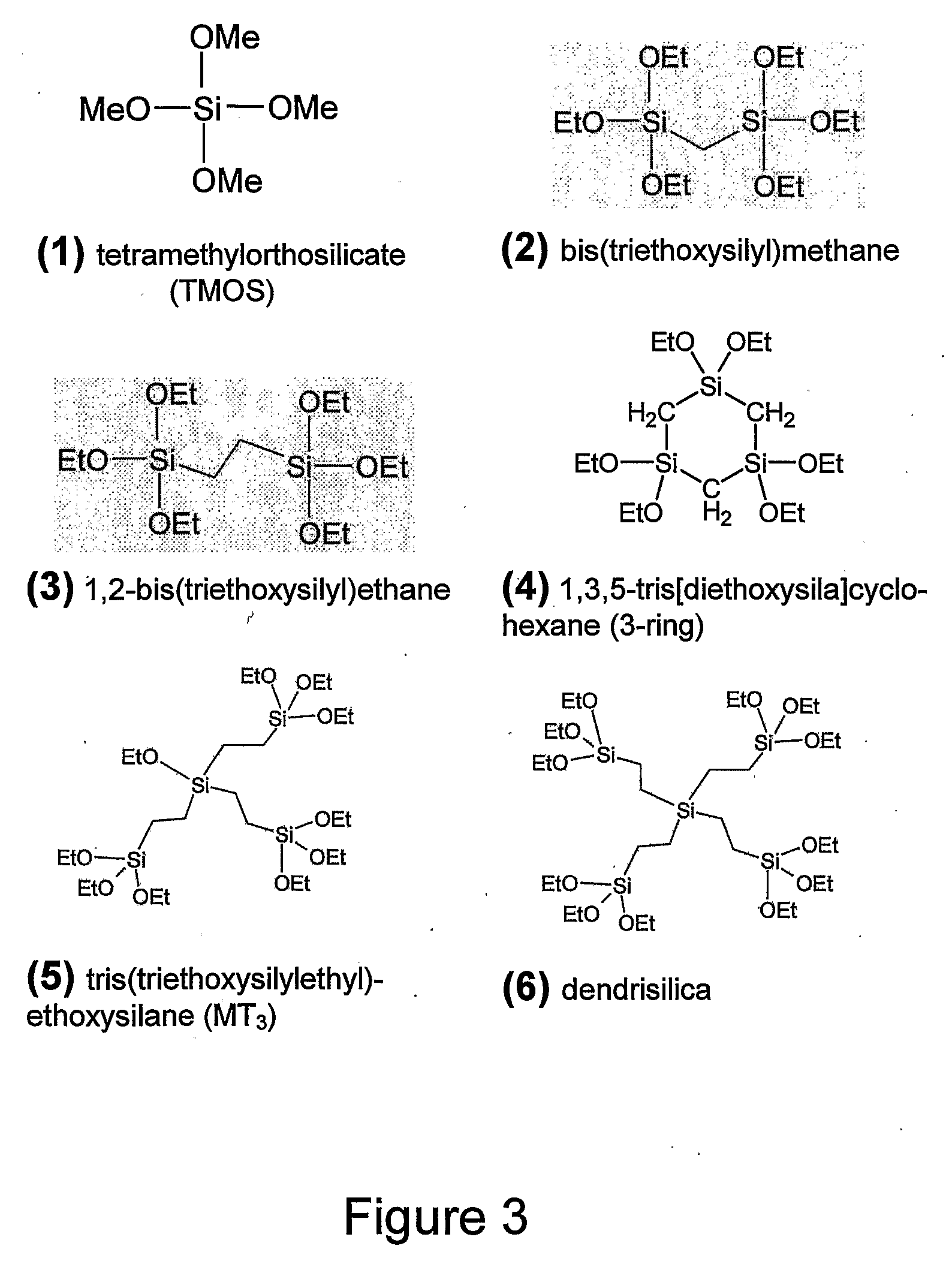Method of transformation of bridging organic groups in organosilica materials
- Summary
- Abstract
- Description
- Claims
- Application Information
AI Technical Summary
Benefits of technology
Problems solved by technology
Method used
Image
Examples
example 1
Methene PMO
[0100]Methene PMO films were synthesized using the (EtO)3S1—CH2—Si(EtO)3 (Gelest, 98%) organosilane precursor (2 in FIG. 3) (see Hatton et al 2005). A typical synthesis would involve mixing 0.356 g of 10−3M HCl, 1.135 g EtOH, and 0.450 g aqueous cetyltrimethylammonium chloride (CTACl) solution (25 wt. %, Aldrich) to make a homogeneous solution, then adding 0.419 g of (EtO)3S1—CH2—Si(EtO)3 (molar ratio 1.0:31.3:2.89×10−4:10:0.285 of (EtO)3S1—CH2—Si(EtO)3:H2O:HCl:EtOH:CTACl). Films were spin-coated on Si wafer at speeds of 2000 to 4000 rpm, then calcined at 300° C. under nitrogen (1° C. / min ramp, 5 h hold). Following calcination, various additional thermal treatments were applied under nitrogen for 2 h.
[0101]Films with varying organic content were synthesized using mixtures of the silica (TMOS, 1 in FIG. 3) and the silsesquioxane precursor, defined by the molar ratio, F. Since these PMOs contain T-sites for Si, where T1,2,3 corresponds to RSi(OSi)x(OH)3-x tetrahedral sites,...
example 2
Ethene PMO
[0111]Ethene PMO films were synthesized using the (EtO)3S1—CH2CH2—Si(EtO)3 (Aldrich, 96%) organosilane precursor (3 in FIG. 3). A typical synthesis involved mixing 0.356 g of 10−3M HCl, 0.5675 g EtOH, and 0.450 g aqueous cetyltrimethylammonium chloride (CTACl) solution (25 wt. %, Aldrich) to make a homogeneous solution, then adding 0.437 g of (EtO)3SiCH2CH2Si(OEt)3 (molar ratio 1.0:31.3:2.89×10−4:5:0.285 of (EtO)3SiCH2CH2Si(OEt)3:H2O:HCl:EtOH:CTACl).
[0112]As for example 1; films with varying organic content were synthesized using mixtures of TMOS and the silsesquioxane precursors. Thus, precursors TMOS and (EtO)3SiCH2CH2Si(OEt)3 were mixed for molar fractions of the Si sites FT=T: (T+Q)=0, 0.25, 0.5, 0.75, and 1 (according to equation 1). Films were spin-coated on Si wafer at speeds of 2000 to 4000 rpm, then calcined at 300° C. under nitrogen (1° C. / min ramp, 5 h hold). Following calcination, various additional thermal treatments were applied under nitrogen for 2 h.
[0113]F...
example 3
3-Ring PMO
[0122]Films of the 3-ring PMO were synthesized using the cyclic 3-ring [(EtO)2SiCH2]3 organosilane precursor (4 in FIG. 3) (see Landskron et al 2003). A typical synthesis involved mixing 0.356 g of 10−3M HCl, 0.568 g EtOH, and 0.450 g aqueous cetyltrimethylammonium chloride (CTACl) solution (25 wt. %, Aldrich) to make a homogeneous solution, then adding 0.488 g of [(EtO)2SiCH2]3 (molar ratio 1.0:31.3:2.89×10−4:10:0.285 of [(EtO)2SiCH2]3:H2O:HCl:EtOH:CTACl). Films were spin-coated on Si wafer at speeds of 2000 to 4000 rpm, then calcined at 300° C. under nitrogen (1° C. / min ramp, 5 h hold). Following calcination, various additional thermal treatments were applied under nitrogen for 2 h.
[0123]Films with varying organic content were synthesized using mixtures of TMOS and [(EtO)2SiCH2]3, according to the molar ratio, FD. Since these PMOs contain D-sites for Si, where D1,2,3 corresponds to (CH2)2Si(OSi)x(OH)2-x tetrahedral sites, FD is defined by,
FD=13(nring)13(nring)+nTMOS[2]
wh...
PUM
| Property | Measurement | Unit |
|---|---|---|
| Temperature | aaaaa | aaaaa |
| Pore size | aaaaa | aaaaa |
| Pore size | aaaaa | aaaaa |
Abstract
Description
Claims
Application Information
 Login to View More
Login to View More - R&D
- Intellectual Property
- Life Sciences
- Materials
- Tech Scout
- Unparalleled Data Quality
- Higher Quality Content
- 60% Fewer Hallucinations
Browse by: Latest US Patents, China's latest patents, Technical Efficacy Thesaurus, Application Domain, Technology Topic, Popular Technical Reports.
© 2025 PatSnap. All rights reserved.Legal|Privacy policy|Modern Slavery Act Transparency Statement|Sitemap|About US| Contact US: help@patsnap.com



